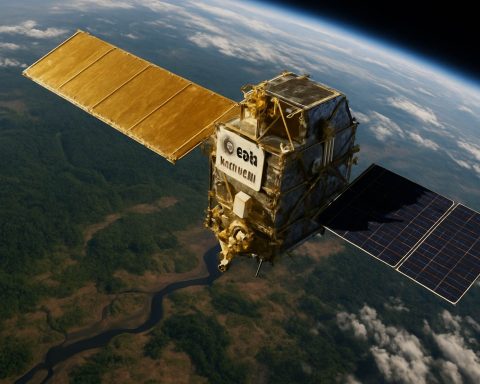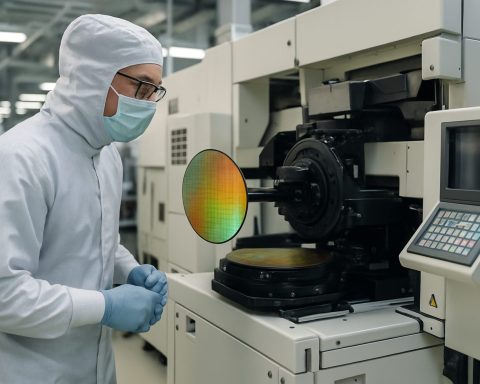- Applied EV and Oxa have partnered to revolutionize logistics through autonomous transportation.
- They are deploying Blanc Robots, autonomous vehicles equipped with Oxa’s self-driving software, across industries.
- The partnership offers a “turnkey solution” with Applied EV’s OEM-grade platform and Oxa’s autonomy software.
- The initial rollout includes 100 robots, expanding to APAC, the UK, EU, and US markets.
- The vehicle-as-a-service model allows businesses to lease and deploy scalable autonomous fleets.
- This collaboration aims to overcome driver shortages, safety issues, and productivity constraints in logistics.
- The initiative sets a new industry standard, heralding a future where autonomous systems integrate seamlessly into logistics operations.
In a bold step towards the future, the realm of logistics is undergoing a technical revolution that promises efficiency and innovation. Emerging from the bustling synergy of technology and industry, Applied EV and Oxa have cemented a groundbreaking partnership, unveiling a blueprint for what could be the new era of autonomous transportation. Picture convoys of Blanc Robots—sleek, autonomous vehicles gliding through warehouses, ports, and cities—integrating seamlessly into daily operations thanks to Oxa’s cutting-edge self-driving software.
These two powerhouses have joined forces to create a modular, self-sufficient fleet capable of revolutionizing how we think about industrial mobility. Applied EV’s robust, OEM-grade vehicle platform now serves as the backbone, dynamically controlled by Oxa’s sophisticated autonomy software. This “turnkey solution” is not just a concept; it’s the future unfolding in real-time, ready to tackle the logistical challenges faced by industries today.
Imagine a logistics system without the hurdles of driver shortages, safety concerns, and productivity constraints. The initial rollout of 100 Blanc Robots equipped with the Oxa Driver system marks the beginning of a widespread commercial deployment strategy. This rollout is set to expand into a formidable force across key markets, including APAC, the UK, EU, and US, thus redefining logistics, agriculture, and mining sectors around the globe.
The promise of this partnership lies in its scalability and the transformative potential it holds. Applied EV and Oxa are not merely implementing technological upgrades; they are redefining logistics paradigms through a unique vehicle-as-a-service model. This fosters an ecosystem where businesses can lease and deploy autonomous fleets designed to adapt and grow with the industry’s evolving demands.
But why does this matter? Beyond the technical prowess is a narrative of efficiency, reliability, and safety that resonates on a global scale. As these Blanc Robots commence their silent, tireless march into the heart of industry, they signal an era where autonomy is not just an aspiration but a tangible reality, shaping our cities and industries with precision and intelligence.
At its core, the collaboration between Applied EV and Oxa is a prelude to a future where autonomous vehicles seamlessly integrate into everyday logistics, ultimately simplifying complex operations and setting a new industry standard. As this future unfolds, it beckons businesses to explore the limitless possibilities of autonomous integration, all while navigating a rapidly transforming landscape of mobility. This is not merely an evolution; it’s a revolution in the making.
The Rise of Autonomous Logistics: How Applied EV and Oxa Are Building the Future
Introduction: A New Era in Logistics
The logistics industry is on the cusp of a transformation, spearheaded by the innovative partnership between Applied EV and Oxa. With the introduction of autonomous Blanc Robots, these companies are setting a new benchmark for efficiency and innovation in industrial mobility. But what does this mean for the future of logistics, and what are the implications for businesses globally?
Exploring the Partnership: Powerhouses of Innovation
Applied EV’s Vehicle Platform: Known for its robust design tailored for industrial applications, Applied EV provides a modular, OEM-grade vehicle platform that acts as a uniform foundation for these autonomous vehicles.
Oxa’s Autonomy Software: Oxa brings to the table sophisticated self-driving technology that integrates seamlessly with Applied EV’s vehicles, offering precise and reliable autonomous driving capabilities.
Key Advantages: Efficiency, Safety, and Scalability
1. Overcoming Driver Shortages: Autonomous vehicles present a viable solution to the growing issue of driver shortages, ensuring continuity in operations without relying on human drivers.
2. Enhanced Safety Features: With a lower margin for human error, Blanc Robots are expected to reduce accidents and enhance the safety metrics within logistics operations.
3. Scalability: The “vehicle-as-a-service” model allows businesses to scale their operations efficiently, adapting to market demands without substantial upfront investment.
Market Impact and Future Trends
– Global Deployment: The initial rollout plan includes diverse markets such as APAC, the UK, EU, and the US, positioning these regions at the forefront of autonomous logistics innovation.
– Sector Transformation: Key sectors like agriculture, mining, and urban logistics will experience transformative impacts, improving productivity and operational flexibility.
How-To Steps & Life Hacks: Integrating Autonomous Fleets
1. Assess Needs: Determine which areas of your operation can benefit most from autonomous vehicles.
2. Pilot Program: Start with a small-scale implementation to test the integration of autonomous vehicles within your existing framework.
3. Training and Transition: Train staff on interacting with and overseeing autonomous operations to ensure a smooth transition and maximum benefit extraction.
4. Evaluation and Expansion: Constantly evaluate the performance and benefits, and expand the fleet as needed according to business growth.
Real-World Use Cases
Logistics: Autonomous vehicles can streamline warehouse operations by efficiently moving goods and reducing waiting times.
Agriculture: In agriculture, these vehicles can be deployed to perform tasks such as planting and harvesting, optimizing agricultural productivity.
Mining: In mining, autonomous fleets provide a safer alternative for transporting materials, thus minimizing human exposure to hazardous environments.
Controversies & Limitations
– Regulatory Challenges: The deployment of autonomous vehicles faces regulatory hurdles that vary by region, requiring navigation of complex legal landscapes.
– Technological Reliability: While advancements have been made, the technology is not infallible and requires continuous software updates and monitoring.
Security & Sustainability
– Data Security: Ensuring the security of autonomous vehicle systems against cyber threats is crucial for maintaining operational integrity.
– Sustainability Efforts: Many autonomous vehicle projects are increasingly focused on sustainable energy solutions, reducing carbon footprints in logistics.
Actionable Recommendations
– Stay Informed: Continuously research the latest developments in autonomous vehicle technology to understand how they can benefit your business.
– Start Small: Implement autonomous technology in small, manageable phases to mitigate risks and gather meaningful data on its impact.
Conclusion: Embrace the Autonomous Revolution
As the collaboration between Applied EV and Oxa demonstrates the potential of autonomous vehicles, businesses must explore this innovative path to remain competitive. With challenges like driver shortages and safety concerns addressed, autonomous logistics offers a promising future of efficiency and sustainability.
For more insights into logistics innovations, visit Global Logistics Media and stay updated on the latest industry trends.









